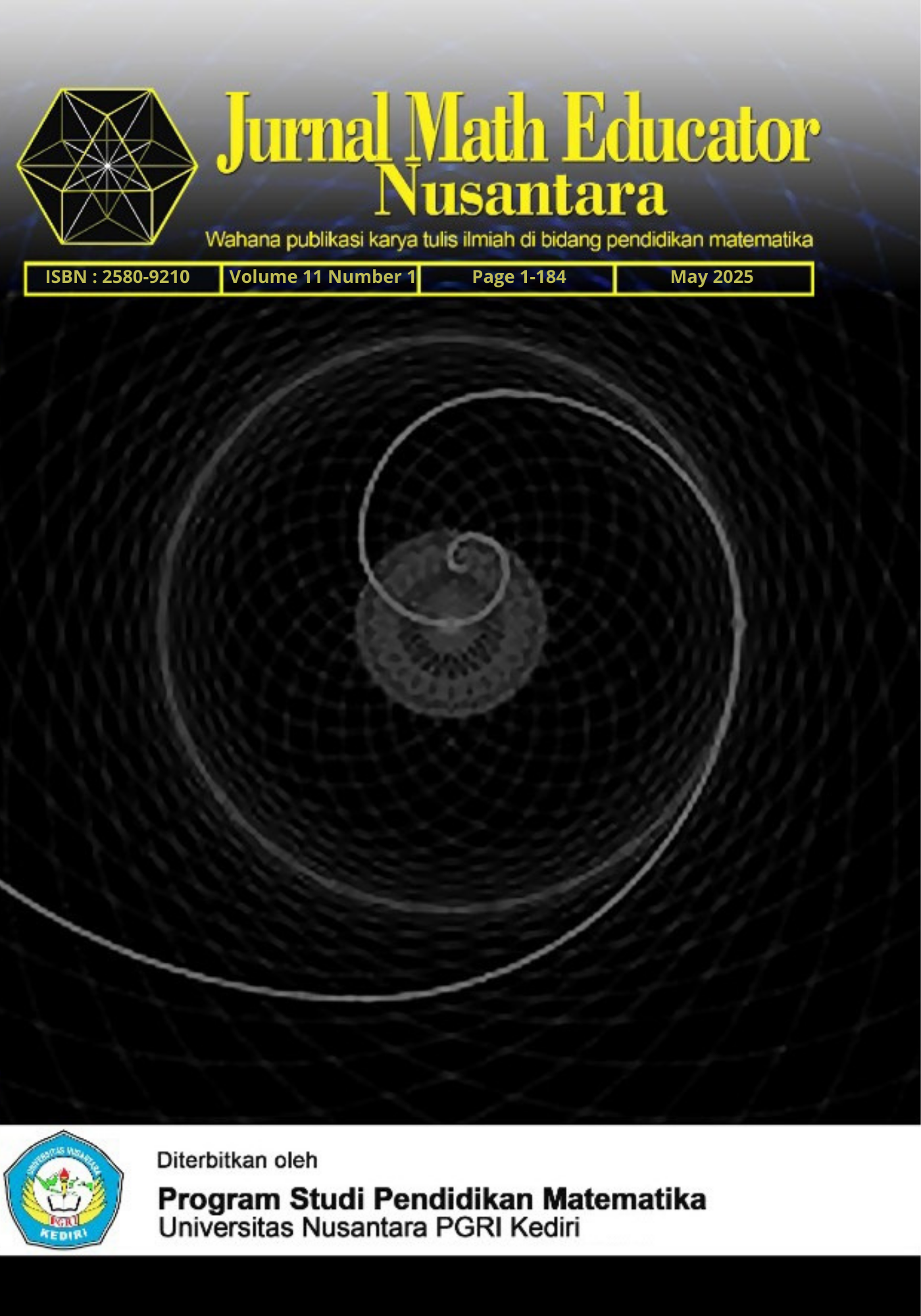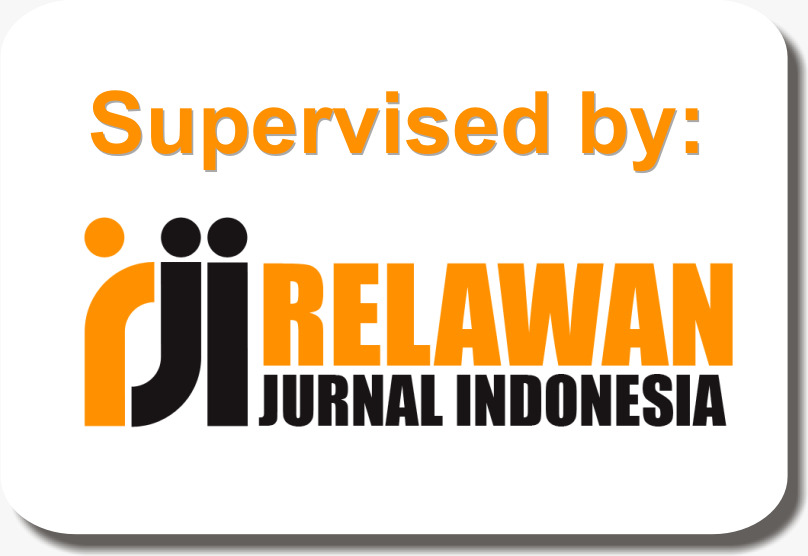Digital trigonometry module utilizing liveworksheet to enhance university students' mathematical communication skills
DOI:
https://doi.org/10.29407/jmen.v11i1.24036Keywords:
Digital trigonometry module, LiveWorksheet, mathematical communication skills, research and developmentAbstract
Supporting the development of university students’ cognitive skills in higher education necessitates the design of instructional materials that cultivate critical thinking. Integrating technology into teaching resources has become prevalent in higher education, proving effective in advancing students' skills. This study aims to evaluate the validity of a digital trigonometry module based on LiveWorksheet, assess its practicality from the users' perspective, and determine its effectiveness in enhancing mathematical communication skills. The study follows a research and development with five phases: (1) analysis, (2) design, (3) development, (4) implementation, and (5) evaluation. Participants included two experts-one in mathematics education and another in ICT education and 62 students (Class A, n=32; Class B, n=30). These students were enrolled in a trigonometry course taught by the researcher. Data were gathered via questionnaires and mathematical communication skill assessments, with qualitative descriptive analysis used to address the research objectives. Results indicate that the digital trigonometry module meets established validity criteria. The implementation findings demonstrate that the module is both practical for users and effective in enhancing students' mathematical communication skills, with average student performance reaching a high level. These findings suggest that LiveWorksheet-based digital instructional materials, particularly when incorporating media such as videos and interactive quizzes, can significantly enrich learning support
References
Akbar, S. d. (2013). Instrumen perangkat pembelajaran. PT Remaja Rosdakarya.
Fonda, A., & Sumargiyani, S. (2018). the Developing Math Electronic Module With Scientific Approach Using Kvisoft Flipbook Maker Pro for Xi Grade of Senior High School Students. Infinity Journal, 7(2), 109. https://doi.org/10.22460/infinity.v7i2.p109-122
Harianto, A., Suryanti, S., & Khery, Y. (2017). Pengembangan media pembelajaran kimia berbasis Android untuk penumbuhan literasi sains siswa pada materi reaksi redoks dan elektrokimia. Jurnal Kependidikan Kimia, 5(2), 35–47.
Indiyanti, I., Asmarani, D., & Sutopo, S. (2023). Development of hots-based math textbooks to improve critical thinking skills. Jurnal Math Educator Nusantara: Wahana Publikasi Karya Tulis Ilmiah Di Bidang Pendidikan Matematika, 9(2), 156-170. https://doi.org/10.29407/jmen.v9i2.20033
Jayadiningrat, M. G., & Ati, E. K. (2018). Peningkatan keterampilan memecahkan masalah melalui model pembelajaran problem based learning (Pbl) pada mata pelajaran kimia. Jurnal Pendidikan Kimia Indonesia, 2(1). https://doi.org/10.23887/jpk.v2i1.14133.
Junaidi, A. (2020). Panduan penyusunan kurikulum pendidikan tinggi. In IREKTORAT JENDERAL PENDIDIKAN TINGGI KEMENTERIAN PENDIDIKAN DAN KEBUDAYAAN.
Kefalis, C., & Drigas, A. (2021). Web based and online applications in STEM education. International Journal of Engineering Pedagogy, 9(4), 76–85.
Landis, J. R., & Koch, G. G. (1977). The Measurement of Observer Agreement for Categorical Data. Biometrics, 33, 159–174.
Mutmainnah, A., & Warneri. (2021). Efektivitas Penggunaan E-Modul Terhadap Hasil Belajar Kognitif Pada Materi Sistem Pencernaan Manusia Di Madrasah Tsanawiyah. Jurnal Basicedu Journal of Elementary Education, 5(3). https://doi.org/10.31004/basicedu.v5i3.952
NCTM. (2000). Principles and standards for school mathematics. Author.
Nieveen, N., & Folmer, E. (2013). Formative evaluation in educational design research. Design Research, 153(1), 152-169.
Permana, I., Zulhijatiningsih, Z., & Kurniasih, S. (2021). Efektivitas E-Modul Sistem Pencernaan Berbasis Problem Solving Terhadap Kemampuan Pemecahan Masalah. Jurnal IPA & Pembelajaran IPA, 5(1), 36–47. https://doi.org/10.24815/jipi.v5i1.18372
Plomp, T., & Nieveen, N. (2013). Educational Design Research. Educational Design Research, 1–206. https://doi.org/10.1007/978-1-4614-3185-5_11
Puncreobutr, V. (2016). Education 4.0: new challenge of learning. Journal of Humanities and Social Sciences, 2(2). https://doi.org/10.4236/ce.2012.32040
Rizal, R., Ganefri, G., & Ambiyar, A. (2024). Developing a project-based learning-based e-module to enhance critical thinking skills on vocational students. Jurnal Pendidikan Teknologi Kejuruan, 7(3), 213-228. https://doi.org/10.24036/jptk.v7i3.37923
Rohmaini, L., Netriwati, N., Komarudin, K., Nendra, F., & Qiftiyah, M. (2020). Pengembangan Modul Pembelajaran Matematika Berbasis Etnomatematika Berbantuan Wingeom Berdasarkan Langkah Borg and Gall. Teorema: Teori Dan Riset Matematika, 5(2), 176. https://doi.org/10.25157/teorema.v5i2.3649
Soulé, H., & Warrick, T. (2015). Defining 21st century readiness for all students: what we know and how to get there. Psychology of Aesthetics, Creativity, and the Arts, 9, 17–186. https://doi.org/10.1037/aca0000017
Susanta, A., Koto, I., & Susanto, E. (2022). Teachers' Ability in Writing Mathematical Literacy Module Based on Local Context. Education Quarterly Reviews, 5(3), 173–179. https://doi.org/10.31014/aior.1993.05.03.536
Susanta, A., Sumardi, H., & Zulkardi, Z. (2022). Development of e-module using Bengkulu contexts to improve literacy skills of junior high school students. Jurnal Pendidikan Matematika, 16(2), 171-186.
Susanto, E., Rusdi, R., & Susanta, A. (2021). Pembelajaran matematika realistik berbasis budaya masyarakat Bengkulu dalam meningkatkan komunikasi matematis mahasiswa [Realistic mathematics learning based on Bengkulu community culture in improving student mathematical communication. Jurnal Pendidikan Matematika Raflesia, 6(1), 39–49.
Susanto, E., & Susanta, A. (2022). Efektivitas E-Modul Interaktif Berbasis Pembelajaran Project Ditinjau Dari Kemampuan Literasi Matematis Dan Kepercayaan Diri Mahasiswa. Jurnal Silogisme: Kajian Ilmu Matematika Dan Pembelajarannya, 7(1), 1–13. https://doi.org/10.24269/silogisme.v7i1.5181
Susanto, E., Susanta, A., Rusnilawati, & Ali, S. R. B. (2024). Developing STEAM-teaching module in supporting students' literacy ability in elementary school. Jurnal Pendidikan Matematika (JPM, 18(3), 349–366. https://doi.org/10.22342/jpm.v18i3.pp349-366
Tobing, H. E. L., Somakim, S., & Susanti, E. (2021). Development of E-Module Based on HOTS Questions on Distance Material for High School Students. Jurnal Pendidikan Matematika, 16(1), 1–14. https://doi.org/10.22342/jpm.16.1.14694.1-14
Wijaya, E., Sudjimat, D., & Nyoto, A. (2016). Transformasi pendidikan abad 21 sebagai tuntutan pengembangan sumber daya manusia di era global. In Proseding Seminar Nasional Pendidikan Matematika (pp. 263–278). https://repository.unikama.ac.id/840
Yuniastuti, M., & Khoiron, M. (2021). Media Pembelajaran Untuk Generasi Milenial (Tinjauan Teoritis dan Pedoman Praktis. Angewandte Chemie International Edition, 6(11), 951–952.
Downloads
Published
Issue
Section
License
Copyright (c) 2025 Edi Susanto, Dewi Rahimah, Effie Efrida Muchlish, Siti Rochana

This work is licensed under a Creative Commons Attribution 4.0 International License.
Authors who publish with this journal agree to the following terms:
- Copyright on any article is retained by the author(s).
- The author grants the journal, the right of first publication with the work simultaneously licensed under a Creative Commons Attribution License that allows others to share the work with an acknowledgment of the work’s authorship and initial publication in this journal.
- Authors are able to enter into separate, additional contractual arrangements for the non-exclusive distribution of the journal’s published version of the work (e.g., post it to an institutional repository or publish it in a book), with an acknowledgment of its initial publication in this journal.
- Authors are permitted and encouraged to post their work online (e.g., in institutional repositories or on their website) prior to and during the submission process, as it can lead to productive exchanges, as well as earlier and greater citation of published work.
- The article and any associated published material is distributed under the Creative Commons Attribution-ShareAlike 4.0 International License
















